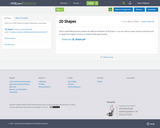
CESA #1 EL OER Project 2D Shapes slideshow, visual aides
- Subject:
- Mathematics
- Material Type:
- Lesson
- Date Added:
- 05/25/2018

CESA #1 EL OER Project 2D Shapes slideshow, visual aides
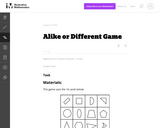
In this game activity students practice comparing shapes and naming something that is alike or different about them.

In this math activity, learners explore the history of the Stomachion (an ancient tangram-type puzzle), use the pieces to create other figures, learn about symmetry and transformations, and investigate the areas of the pieces. The Stomachion, believed to have been created by Archimedes, consists of 14 pieces cut from a square, which can be rearranged to form other interesting shapes.
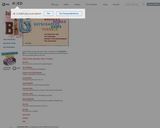
This is a great lab that walks students through interactive labs that include Forces, Loads, Materials and Shapes and how they affect the way we design and build structures. Pairs really nicely with any design and build lab assignments like Bridges, Cranes, etc.

Students learn about isometric drawings and practice sketching on triangle-dot paper the shapes they make using multiple simple cubes. They also learn how to use coded plans to envision objects and draw them on triangle-dot paper. A PowerPoint® presentation, worksheet and triangle-dot (isometric) paper printout are provided. This activity is part of a multi-activity series towards improving spatial visualization skills.
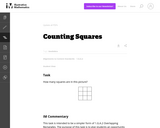
This challenging problem and brainteaser gives first graders an opportunity to compose and decompose squares.

In this activity, learners use pattern blocks and mirrors to explore symmetry. Learners work in pairs and build mirror images of each other's designs. In doing so, learners will examine principles of symmetry and reflection.

In this activity, learners design unique tiles and make repeating patterns to create tessellations. This activity combines the creativity of an art project with the challenge of solving a puzzle. This lesson features three investigations, in which learners make tessellations by translating, rotating, and reflecting the patterns.

In this activity, learners repeat patterns in two and three dimensions to create tessellations. This activity combines the creativity of an art project with the challenge of solving a puzzle. This lesson features three investigations that are appropriate for varying grades and levels.

This task presents students with some creative geometric ways to represent the fraction one half. The goal is both to appeal to students' visual intuition while also providing a hands on activity to decide whether or not two areas are equal.
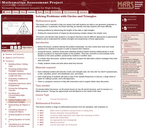
This lesson unit is intended to help teachers assess how well students are able to use geometric properties to solve problems. In particular, the lesson will help you identify and help students who have the following difficulties: solving problems by determining the lengths of the sides in right triangles; and finding the measurements of shapes by decomposing complex shapes into simpler ones. The lesson unit will also help students to recognize that there may be different approaches to geometrical problems, and to understand the relative strengths and weaknesses of those approaches.

In Module 5, students consider partwhole relationships through a geometric lens. The module opens with students identifying the defining parts, or attributes, of two- and three-dimensional shapes, building on their kindergarten experiences of sorting, analyzing, comparing, and creating various two- and three-dimensional shapes and objects. Students combine shapes to create a new whole: a composite shape. They also relate geometric figures to equal parts and name the parts as halves and fourths. The module closes with students applying their understanding of halves to tell time to the hour and half hour.
Find the rest of the EngageNY Mathematics resources at https://archive.org/details/engageny-mathematics.

Module 2 explores two-dimensional and three-dimensional shapes. Students learn about flat and solid shapes independently as well as how they are related to each other and to shapes in their environment. Students begin to use position words when referring to and moving shapes. Students learn to use their words to distinguish between examples and non-examples of flat and solid shapes.
Find the rest of the EngageNY Mathematics resources at https://archive.org/details/engageny-mathematics.

Kindergarten comes to a close with another opportunity for students to explore geometry in Module 6. Throughout the year, students have built an intuitive understanding of two- and three-dimensional figures by examining exemplars, variants, and non-examples. They have used geometry as a context for exploring numerals as well as comparing attributes and quantities. To wrap up the year, students further develop their spatial reasoning skills and begin laying the groundwork for an understanding of area through composition of geometric figures.
Find the rest of the EngageNY Mathematics resources at https://archive.org/details/engageny-mathematics.
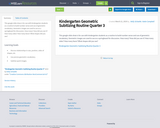
This google slide show is for use with kindergarten students as a routine to build number sense and use of geometric vocabulary. Geometric images are used to use as a springboard for discussion. How many? How did you see it? How many sides? How many faces? What shapes did you see?
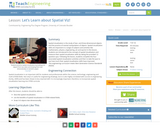
Spatial visualization is the study of two- and three-dimensional objects and the practice of mental manipulation of objects. Spatial visualization skills are important in a range of subjects and activities like mathematics, physics, engineering, art and sports! In this lesson, students are introduced to the concept of spatial visualization and measure their spatial visualization skills by taking the provided 12-question quiz. Following the lesson, students complete the four associated spatial visualization activities and then re-take the quiz to see how much their spatial visualization skills have improved.
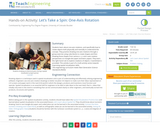
Students learn about one-axis rotations, and specifically how to rotate objects both physically and mentally to understand the concept. They practice drawing one-axis rotations through a group exercise using cube blocks to create shapes and then drawing those shapes from various x-, y- and z-axis rotation perspectives on triangle-dot paper (isometric paper). They learn the right-hand rule to explore rotations of objects. A worksheet is provided. This activity is part of a multi-activity series towards improving spatial visualization skills.
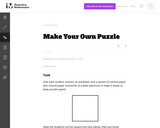
This instructional task gives students a hands-on experience with composing and decomposing geometric figures.

In this activity, learners slide shapes to create unusual tiled patterns. Learners transform a rectangle into a more interesting shape and then make a tessellation by repeating that shape over and over again. Learners will also calculate the area of a rectangle. This activity works best as a "centers" activity.

(Nota: Esta es una traducción de un recurso educativo abierto creado por el Departamento de Educación del Estado de Nueva York (NYSED) como parte del proyecto "EngageNY" en 2013. Aunque el recurso real fue traducido por personas, la siguiente descripción se tradujo del inglés original usando Google Translate para ayudar a los usuarios potenciales a decidir si se adapta a sus necesidades y puede contener errores gramaticales o lingüísticos. La descripción original en inglés también se proporciona a continuación.)
En el módulo 5, los estudiantes consideran parte de las relaciones completas a través de una lente geométrica. El módulo se abre con estudiantes que identifican las partes definidas, o atributos, de formas dos y tridimensionales, basándose en sus experiencias de jardín de infantes de clasificación, análisis, comparación y creación de varias formas y objetos de dos y tridimensionales. Los estudiantes combinan formas para crear un nuevo todo: una forma compuesta. También relacionan las figuras geométricas con partes iguales y nombran las partes como mitades y cuartos. El módulo se cierra con estudiantes que aplican su comprensión de las mitades para decir tiempo a la hora y media hora.
Encuentre el resto de los recursos matemáticos de Engageny en https://archive.org/details/engageny-mathematics.
English Description:
In Module 5, students consider partwhole relationships through a geometric lens. The module opens with students identifying the defining parts, or attributes, of two- and three-dimensional shapes, building on their kindergarten experiences of sorting, analyzing, comparing, and creating various two- and three-dimensional shapes and objects. Students combine shapes to create a new whole: a composite shape. They also relate geometric figures to equal parts and name the parts as halves and fourths. The module closes with students applying their understanding of halves to tell time to the hour and half hour.
Find the rest of the EngageNY Mathematics resources at https://archive.org/details/engageny-mathematics.